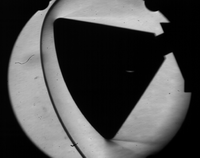当前位置:
X-MOL 学术
›
Phys. Rev. Fluids
›
论文详情
Our official English website, www.x-mol.net, welcomes your
feedback! (Note: you will need to create a separate account there.)
Microroughness-induced disturbances in supersonic blunt body flow
Physical Review Fluids ( IF 2.5 ) Pub Date : 2020-06-26 , DOI: 10.1103/physrevfluids.5.063903 Thomas Schilden , Alexej Pogorelov , Sohel Herff , Wolfgang Schröder
Physical Review Fluids ( IF 2.5 ) Pub Date : 2020-06-26 , DOI: 10.1103/physrevfluids.5.063903 Thomas Schilden , Alexej Pogorelov , Sohel Herff , Wolfgang Schröder

|
To identify the mechanism triggering boundary layer transition on a spherical forebody of an Apollo type re-entry capsule direct numerical simulations of perturbed flow are analyzed. The perturbations are generated by deterministic distributed surface roughnesses that resemble model surface imperfections that are mounted on a capsule model and are experimentally investigated in Radespiel et al. [J. Spacecr. Rockets 56, 405 (2019)]. Therein, the role of distributed roughness in the transition scenario was highlighted but the mechanism remained unclear. In this manuscript, the sensitivity of the flow perturbations with respect to the roughness layout is investigated. The great span of spatial scales, i.e., capsule diameter, boundary layer thickness, and micro-size roughness, define the requirements of the numerical method. Modifications to a finite-volume unstructured Cartesian cut-cell method to meet these requirements are presented. The receptivity of the capsule boundary layer to the roughness and the subsequent disturbance growth are analyzed. The roughness properties at the most downstream position govern the flow perturbation. The impact of the streamwise character of the roughness layout is intensified by increasing the Reynolds number of the flow. The growth mechanism is identified as transient growth and the most amplified disturbances are compared to the results of optimal transient growth theory. Streamwise vortices cause growth via the lift-up effect. However, the wall normal scales of optimal and roughness induced disturbance differ significantly leading to suboptimal growth.
中文翻译:

超音速钝体流中的微粗糙度引起的扰动
为了确定触发阿波罗型可再入舱的球形前体上边界层转变的机制,分析了扰动流的直接数值模拟。扰动是由确定性的分布表面粗糙度产生的,该表面粗糙度类似于安装在胶囊模型上的模型表面缺陷,并在Radespiel等人的实验中进行了研究。[ J. Spacecr。火箭 56,405(2019)]。其中,强调了分布粗糙度在过渡场景中的作用,但机理尚不清楚。在此手稿中,研究了流动扰动相对于粗糙度布局的敏感性。空间尺度的大范围,即胶囊直径,边界层厚度和微米级粗糙度,定义了数值方法的要求。提出了对满足这些要求的有限体积非结构化笛卡尔切单元方法的修改。分析了胶囊边界层对粗糙度的接受度以及随后的扰动增长。最下游位置的粗糙度特性决定了流量扰动。通过增加流的雷诺数,可以增强粗糙度布局的沿流特性的影响。增长机理被确定为瞬态增长,并且将最大的扰动与最佳瞬态增长理论的结果进行了比较。顺流涡流通过提起效应引起生长。但是,最佳壁厚和粗糙度引起的扰动的正常壁厚差异显着,导致次最佳生长。
更新日期:2020-06-26
中文翻译:

超音速钝体流中的微粗糙度引起的扰动
为了确定触发阿波罗型可再入舱的球形前体上边界层转变的机制,分析了扰动流的直接数值模拟。扰动是由确定性的分布表面粗糙度产生的,该表面粗糙度类似于安装在胶囊模型上的模型表面缺陷,并在Radespiel等人的实验中进行了研究。[ J. Spacecr。火箭 56,405(2019)]。其中,强调了分布粗糙度在过渡场景中的作用,但机理尚不清楚。在此手稿中,研究了流动扰动相对于粗糙度布局的敏感性。空间尺度的大范围,即胶囊直径,边界层厚度和微米级粗糙度,定义了数值方法的要求。提出了对满足这些要求的有限体积非结构化笛卡尔切单元方法的修改。分析了胶囊边界层对粗糙度的接受度以及随后的扰动增长。最下游位置的粗糙度特性决定了流量扰动。通过增加流的雷诺数,可以增强粗糙度布局的沿流特性的影响。增长机理被确定为瞬态增长,并且将最大的扰动与最佳瞬态增长理论的结果进行了比较。顺流涡流通过提起效应引起生长。但是,最佳壁厚和粗糙度引起的扰动的正常壁厚差异显着,导致次最佳生长。











































 京公网安备 11010802027423号
京公网安备 11010802027423号